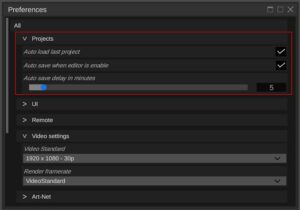Your cart is currently empty!
VSet3D Studio User Guide

User Guide
Rev 1.0.6
Introduction
Vset3D Studio
Vset3D Studio offers a true 3D virtual environment where you can greatly enhance the production value of your project. Our powerful and versatile software allows you to use a wide range of lighting effects and camera controls within every virtual studio offering. All you need is a few yards of green material as a backdrop, a good light source, and a camera to record or stream your video footage.
Once you have the footage on the computer running Vset3D Studio, you can adjust the video keying to remove any of the green from the shot leaving only you or your subject placed in the virtual studio. We provide amazing and professional results at a fraction of the cost to create a similar production in the real world. Best of all, we can do this real time!
Use our software for your live production.
Our software allows you to set several different positions for your virtual camera. These positions can be changed giving the appearance that you have a several camera shoot. The amazing thing about this is that it only requires one camera to get these results.
To use Vset3D’s ray tracing and DLSS options, you must use an NVidia RTX graphics card. Vset3D can be run on an AMD card, but ray tracing and DLSS will not be available.
Table of Contents
About Vset3D Studio
Vset3D is a DirectX 64 Bits software built for Microsoft Windows 10 or 11.
Vset3D can also be started with command line arguments:
- -monitor N Run Vset3D on specified monitor; N = monitor number
- -screen-height Set the screen height resolution
- -screen-width Set the screen width resolution
- -force-d3d11 Start Vset3D Studio in DirectX11
- -force-d3d12 Start Vset3D Studio in DirectX12
- -window-mode Force Vset3D in resizable windows mode
- -screen-fullscreen Force Vset3D in full screen
This starts Vset3D in DirectX11 >> STUDIO.exe -force-d3d11
Ray tracing and DLSS are only available in DirectX 12 mode.
Quick Start
Loading a template :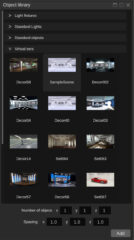
- Select Virtual Sets

- Select the template
- Press Add or double click on it
Load Project :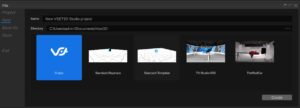
- Open file window
- Select New
- Select your project
- Select Create
Add Output :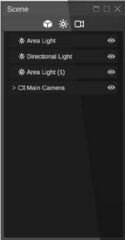
- Create or select one camera
- Add mixer

- Add Output +
- Open Mixer window to start switching
Camera Switching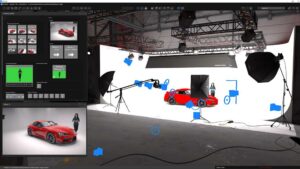
Once you have set all cameras, live inputs and animations you are able to control them from the Control Panel window.
How to work with the Control Panel
There are three ways to use the control panel.
- The Mouse
- The Keyboard
- Network / Stream Deck / companion …
Mouse Camera switching: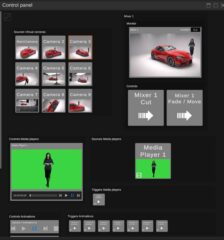
- Click with your mouse on the button corresponding to the camera you wish to switch
- Click Mixer Cut or Mixer Move to start switching or movement
The transition speed can be set with the Monitor Duration value (1 = one second)
Keyboard Camera switching:
- Make sure you have a number pad on your keyboard.
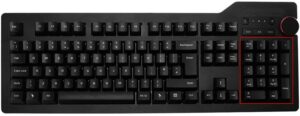
When you create cameras or inputs, Vset3D Studio automatically adds the corresponding button 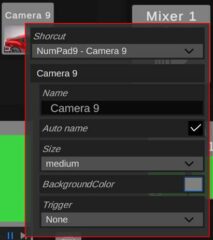
with its shortcut in the Control Panel
You can use Right click to modify settings of any button
Shortcut: Define the Keyboard key which preselects the camera
Name: Use it to rename the button
Auto name: Let Vset3D naming the button
Size: Button size in the Control Panel
Background Color: Set the button color
Trigger: launches the selected animation at the same time that the switching
To switch camera with your keyboard:
Make sure all Control panel shortcuts are correctly assigned.
- Press the number corresponding to the desired camera on the numeric keypad of your keyboard.
- Release
- Press Enter on the num pad to start the switching
Vset3D allows you to have movement between camera positions.
To start movement:
- Press the number corresponding to the desired camera on the numeric keypad of your keyboard.
- Release
- Press + on the num pad to start the movement or Enter to cut
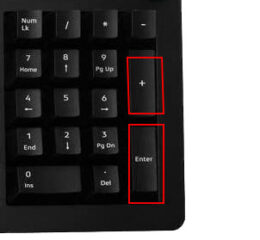
Stream Deck and companion
Stream Deck Companion
Companion
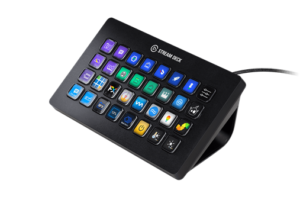
VSet3D Studio can work with Companion and Stream deck or any other device/software able of sending commands over a TCP-IP network.
You can send commands to Vset3D Studio through tcp-udp on Port 7000. Command end character is n
- To select Camera 1 on Mixer 1, use: setpreview: 0 virtualcamera 0 n
- To do a 5 seconds smooth transition to Camera 1on Mixer 1, use: dotransition: 0 fade 5 n
- To do Cut transition to Camera 1 on Mixer 1, use: dotransition: 0 cut n
- To start Media Player 1, use: mediaplayer: 0 play n
- To start Animation, 1use: animation: 0 play n
Vset3D Studio User Interface
The user interface of Vset3D Studio is divided into 3 sections. The top section which shows all the tools icons, the middle section which is the 3D editor view, the bottom section which is the statue section.
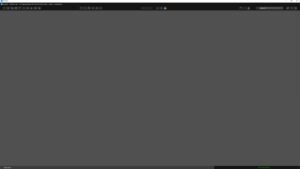
General Tools Icons
![]()
1 2 3 4 5 6 7 8 9 10
- File: Allows you to load and save project
- Sources: Allows you to add live video inputs, NDI, images, media players, to your project
- Scene: Allows you to navigate and select item in your project
- Inspector: Gives you access to the setting of the selected item
- Animation: Allows you to add animation to the selected item
- Rendering: Allows you to add and manage rendering option
- Mixer: Allows you to add live outputs to your project
- Camera Remote Control: Open Camera Remote window
- Control Panel: Open Vset3D Control Panel
- Open Mixer1 monitor
Creation Tools Icons

1 2 3 4 5
- Add Virtual Camera: Allows you to create virtual camera
- Add Camera Facing Plane: Allows you to add plane dedicated to green screen video
- Add Item from library: Allows you to add standard light or fixture, 3D object, primitive
- Add Imported Mesh: Allows you to import single FBX object or full virtual set
- Add Group: Allows you to add dummy objet usefull to group objects in the project
Transform tools Icons

1 2 3
- Move: Allows you to move selected object
- Rotate: Allows you to rotate selected object
- Scale: Allows you to rescale selected object
Editor Quality settings Icons

1 2 3
- Editor OFF: Allows you to turn off 3D editor view to save 3D resources when you are in live.
- Editor quality Draft: Allows you to disable all rendering option available in the Rendering menu
- Editor Quality Full: Allows you to apply all rendering option from the Rendering menu
Editor View Selection

- Front
- Back
- Left
- Right
- Top
- Bottom
- Isometric
- Perspective
Actions Icons
![]()
1 2 3
- Undo
- Redo
- Save Project
Layout menu
![]()
Allows you to save and manage Vset3D Studio windows position
Settings Icons

1 2 3
- Settings: Open project settings window
- Open Help window
- Open Exit menu
3D Editor View
The user interface of Vset3D Studio is divided into 3 sections. The middle section is the 3D editor view.
In this view you will :
- Add Vset3D library
- Import FBX
- Create animations
- Add and adjust light settings and positions
- Add and adjust cameras positions and settings
- Scale and move objects
- Orient and zoom Editor view
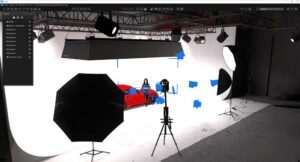
In the editor view you can use Tab to show/hide all opened windows and Escape to reset selected window.
Quality setting icons
![]()
Use the first quality setting icon to stop the editor when you are in live, it will save a lot of GPU Resources.
Use the control panel to switch your cameras. The Mixer monitor can be used as program monitor.
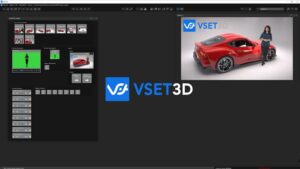
If you have a dual monitor you can assign the mixer output on the 2nd monitor by selecting Display.
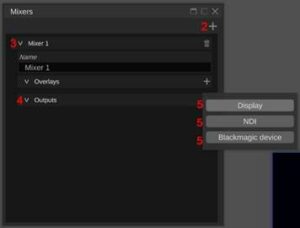
Light Gizmos
- Area light
- Omnidirectional Light
- Direct Light ( Sun )
- Spot Light
![]()
Camera Gizmos
- Camera Gizmo
- Focus target gizmo. Allows you to adjust camera’s Depth of field focus distance.
- Camera target gizmo in Locked to target mode enabled.
![]()
Camera Facing Plane
This object is dedicated to green screen video. Use it to display your talent and do Chroma key.
![]()
This object is always oriented towards the selected Mixer
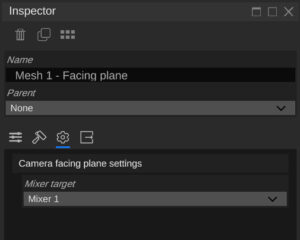
Group
Group is an invisible object that allows you to parent Lights or objects
Point Lights Group holds 4 spotlights. Example below :
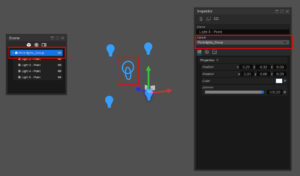
Primitive Meshes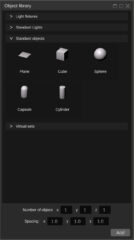
Vset3D comes with build in primitive objects
- Plane
- Cube
- Sphere Cylinder
- Capsule
UI language
This Option allows you to set Vset3D UI language
Auto load auto Backup
This Option allows you to manage the Auto load and Auto save options
Remote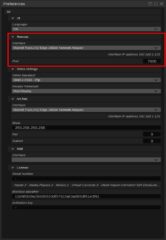
This option allows you to set network interface used to control Vset3D through IP command
Video Settings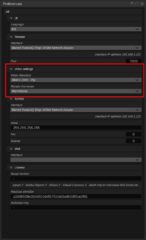
This option allows you to set the project video resolution and frame rate synchronization method.
Always set frame rate and project frame rate to the same value, otherwise you will face dropped frames
Art-Net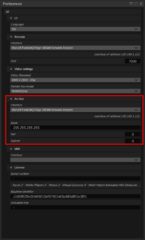
This option allows you to adjust the network device setting used by DMX fixtures.
Midi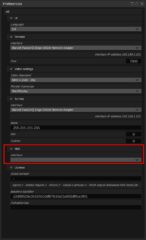
This option allows you to select a MIDI device.
File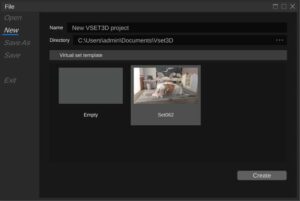
This window allows you to create, load and save your projects.
Sources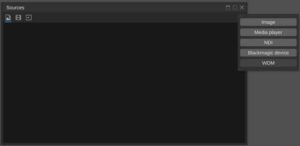
This window allows you to add sources to your project.
Source can be a live video input, NDI stream, video media, png or jpg image.
Vset3D Studio natively supports Blackmagic Decklink devices.
WDM devices are also supported.
Scene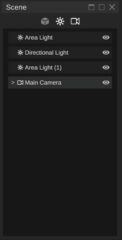
This window allows you to select or show/hide objects from the scene.
You can use the Object, Light, and Camera icons to filter displayed items.
I
nspector
The inspector gives you access to all the parameters and settings of the selected item.
Displayed property depends of the selected item.
Animation
This window allows you to add animation to selected item.
Displayed Property depends of the selected item
Rendering
This window allows you to control rendering quality and rendering settings options.
The Render Quality slider adjust DLSS value and is only available on RTX NVidia graphic cards.
- RTX 20xx
- RTX 30xx
- RTX 40xx
Add settings allows you to add rendering options.
Today’s Available Rendering options:
- Ambient Occlusion
- Beauty
- Bloom
- Color adjustments
- Contact shadows
- Depth of field
- Exposure
- Fog
- HDRI Sky
- Indirect Lighting Controller
- Light Cluster
- Screen Space Global illumination
- Screen Space Reflection
- Split Toning
- Tone mapping
- Vignette
- Visual Environment
- Recursive Rendering (experimental)
Mixer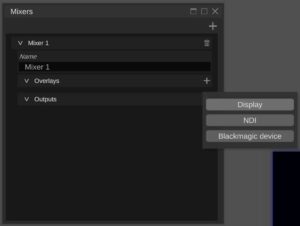
This window allows you to add video outputs to your project.
Outputs can be another monitor, an NDI stream or a Blackmagic Decklink card.
Camera remote
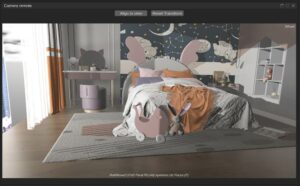
This window shows you the view of the selected camera and allows you to control this camera with your mouse.
Align to view: set orientation of selected camera same as editor.
Reset Transform: resets the camera position and orientation.
Available mouse controls in this window:
Wheel = Field of view
Middle Click = Pan
Alt + Middle Click = Pan/Tilt
Ctrl + Middle Click = Roll
Maj + Wheel = Move forward/backward
A + Wheel = Aperture
F + Wheel = Focus (Add Depth of Field in the render option to enable it)
Layout
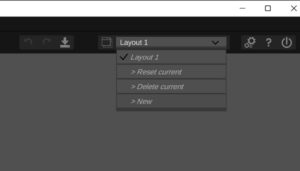
This tool allows you to save Vset3D window position.
- Use New to create a new layout slot.
- Use Reset Current to clear the active layout.
- Use Delete Current to delete active layout.
Use key Tab to show/hide all windows
Use key Esc to reset selected window.
Control Panel
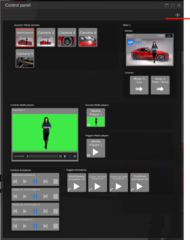
This tool allows you to switch cameras, control animations and media players.
This is a dynamic window. All buttons are automatically created by Vset3D Studio when you add Camera, Media, Animation and Mixer.
Each button has a keyboard shortcut that can be customized (Use right-click to bring up a button’s configuration menu).
Sources Media player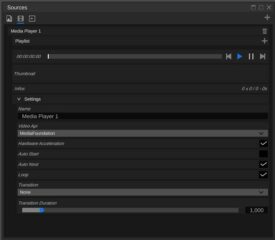
This window allows you to add media players. Each player can handle several videos in a playlist
Chroma Keyer

This window allows you to adjust keyer parameters of the selected Facing plane object.
.
External Matte
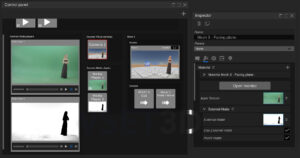
Using an external Keyer with Vset3D streamlines your virtual set production workflow.
Unity 3D Addressables/Librairy
Vset3D is based on the Unity 3D game engine, which allows you to use Unity’s addressable files and create your 3D Set in Unity 3D, then import them into Vset3D Studio as library.
The addressable Library creation documentation comes with the Expert license.

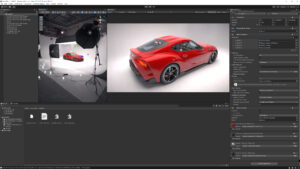
Media File Format
- PNG/JPG
- H264/MPEG/MOV/AVI/
- FBX
DMX Fixtures and Lights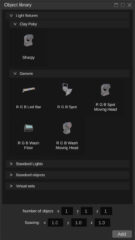
Vset3D comes with fixtures that can be added to your project. They can be animated with the Vset3D animation tool or controlled via DMX device or software.
Generic
- RGB Led Bar
- RGB Spot (PAR 64)
- RGB Spot Moving Head
- RGB Wash
- RGB Wash Moving Head
Clay Paky
- Sharpy
System
- Aera light
- Directional Light
- Point Light
- Spot Light
NDI
Vset3D supports Ndi technology from Newtek. Don’t forget to install Newtek NDI Runtime and NDI Tools.
WDM Devices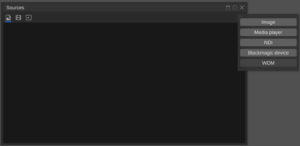
WDM = Windows Driver Mode
Vset3D Studio supports WDM compliant USB video capture device.
BlackMagic Design
Vset3D studio natively supports Blackmagic Decklink devices.
Compatible Video Capture Cards (Tested):
- DeckLink Mini Monitor
- DeckLink Mini Recorder
- DeckLink Mini Monitor 4K
- DeckLink Mini Recorder 4K
- DeckLink Duo 2
- DeckLink 8K Pro
- DeckLink Quad HDMI Recorder
- DeckLink Quad 2
Materials
Standard
• Use it on opaque object (default material)
Double Sided
• Use it to have both sides of the object visible
Transparent
• Use it to on basic semitransparent object.
Transparent Cutout
• Use it on transparent object
Transparent Refraction
• Use it to on refractive semitransparent object. (ex: glasses)
Unlit
• Use it on an object that will not be affected by ambient light conditions
Unlit Transparent Cutout
• Use it on an object that will be transparent and not affected by ambient light conditions
Water River / Water Lake
• Specialized materials dedicated to dynamic water simulation
Video Format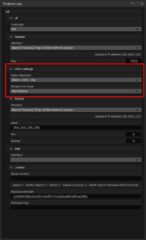
Video format can be set from the Setting window.
Carefully select the resolution and frame rate as they have a direct impact on VSet3D’s performances.
High frame rate and high resolution means high GPU load and can lead to dropped frames.
DLSS/ Render Quality Settings
Render Quality Settings. This
slider adjusts the DLSS level.
DLSS is upsampling technology based on Deep learning and AI.
DLSS allows you to reduce the GPU load on 4K projects.
You need compatible NVidia
GeForce RTX 20xx, RTX 30xx, RTX 30xx graphics card to use DLSS.
Rendering Settings
Ambient Occlusion
Adds a shadow to the contact area between objects and in the corners of the decor.
Beautify
Adds sharpness parameter to the render engine
Bloom
Adds glow on Highlight image parts
Color Adjustments
Adds color & contrast parameter to the render engine
Contact Shadows
Enhances shadow quality at the surface contact (works only with Directional light)
Depth Of Field
Adds camera depth of field control to the render engine
Exposure
Overrides camera exposure
Fog
Adds fog fx to the render engine (must be added to use volumetric lights)
Gradient sky
Adds 3 color gradients sky to the render (needs Visual environment)
HDRI Sky
Allows you to use HDRI image as Sky (needs Visual environment)
Indirect Lighting Control
Adds intensity control on Global illumination and reflection
Screen Space Global illumination
Adds indirect lighting support to the render (supports real-time ray tracing on NVIDIA graphic cards)
Screen Space Reflection
Adds refection support to the render (supports real-time ray tracing on NVIDIA graphic cards)
Screen Space Refraction
Adds refraction support to the render (supports real-time ray tracing on NVIDIA graphic cards)
Tone Mapping
Adds overall image lighting curve control to the render engine
Vignette
Reduces peripheral image brightness
Visual Environment
Adds Sky to the render engine
FreeD camera tracking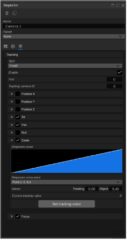
The Vset3D Studio Expert license is FreeD compatible.
This technology makes it possible to carry out augmented
reality projects or projects requiring 3D tracking with 3D tracking data from
FreeD compatible PTZ cameras.
Vset3D Studio is virtual set software that can be used with the Panasonic AW-UE80 4K PTZ or AW-UE100 camera to create live video productions with a green screen.
Vset3D Studio is designed to be easy to use and offers great flexibility for live content creation, thanks to features such as video and image overlay, subject tracking and chroma key.
To use the Panasonic AW-UE80 4K PTZ camera with Vset3D Studio, you will need to connect it to your computer and configure Vset3D Studio to use the camera as a video input source.
You will also need to configure Vset3D Studio’s chroma key and keying settings to achieve professional looking green screen and quality keying.
In summary, Vset3D Studio is virtual set software that can be used with the Panasonic AW-UE80 4K PTZ camera to create live video productions with a green screen. To use these two pieces of equipment together, you will need to connect the camera to your computer and configure Vset3D Studio to use the camera as the video input source. You will also need to configure Vset3D Studio’s chroma key and keying settings to achieve professional looking green screen and quality keying.
To use Vset3D Studio effectively with the Panasonic AW-UE80 4K PTZ camera, there are several steps you should follow. Here are some additional steps to consider when using these two pieces of equipment together:
- Set up your live streaming equipment: Before you start using Vset3D Studio and the Panasonic AW-UE80 4K PTZ camera, you will need to set up your live streaming equipment. This may include configuring your computer, network, and live streaming equipment, such as a live streaming encoder or live streaming server.
- Set up the camera settings: Before you start using the Panasonic AW-UE80 4K PTZ camera with Vset3D Studio, you will need to set up the camera settings. This may include setting the image resolution, shutter speed, frame rate, and other settings that can affect the quality of the image.
- Adjust your green screen lighting: To achieve a professional-quality green screen, you will need to adjust the lighting of your green screen to be uniform and shadow-free. Use diffused lights and reflectors to evenly distribute light across your green screen.
- Calibrate your chroma key: Once you have set up your green screen and lighting, you will need to calibrate your chroma key to achieve high-quality compositing. Use Vset3D Studio’s chroma key settings to adjust the sensitivity and tolerance of your chroma key, and adjust the chrominance and luminance levels to achieve the best possible result.
Calibrate the FreeD camera:
Using a physical plane as a target for 3D tracking camera calibration is a common and effective method.
A physical plane is a flat, two-dimensional object that is easy for the camera’s 3D tracking system to identify and track.
By placing a physical plane in the studio and using it as a reference point, the camera can more accurately track the position and orientation of objects in the studio, which can improve the accuracy of the 3D tracking data.
To use a physical plane as a target for 3D tracking camera calibration, you will need to follow these steps:
- Measure the dimensions of the physical plane: Use a tape measure or other measuring tool to determine the width and length of the physical plane. Make sure to measure the distance between any objects on the plane, such as the distance between the camera and the plane.
- Place the physical plane in the studio: Position the physical plane in the studio according to the dimensions of your studio and the desired position of the camera. Make sure the physical plane is flat and level and that it is positioned at a distance that is appropriate for your camera’s focal length.
- Set up the camera: Position the camera in the studio according to the measurements you took in step 2. Make sure the camera is level and pointed straight ahead.
- Create a virtual plane in Vset3D: Use the measurement you took in step 1 to create a virtual plane in Vset3D that is the same size as the physical plane. Position the virtual plane in front of the virtual camera at the same distance as the physical plane is positioned in front of the physical camera.
- Calibrate the 3D tracking data: Use the camera’s 3D tracking calibration tools to fine-tune the accuracy of the 3D tracking data. This may involve adjusting the camera’s position, orientation, or other settings to ensure that the 3D tracking data is accurate. Make sure to focus the camera on the physical plane and use the physical plane as a reference point for the calibration process.
By following these steps, you should be able to use a physical plane as a target for 3D tracking camera calibration. This will help to improve the accuracy of the 3D tracking data and ensure that the camera is properly positioned for your specific studio setup.
How to Add Light
- Select add library icon

- Select one light from the Lights Library
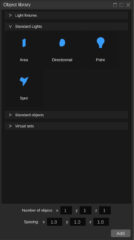
- Press Add or double click on it
- Double click on the light in the 3D view to open the Inspector window
- Adjust light parameters
How to Add Camera
- Select Add Virtual Camera icon, the Camera will be created at the same orientation as the editor 3D view.
- Double click on the Camera gizmo in the 3D view to open Inspector window
- Adjust Camera parameters
Mouse camera controls available from Editor view: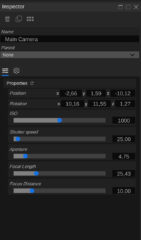
Wheel=Move Backward/Forward
Middle Click=Pan
Alt + Middle Click=Camera orientation
Double Left click=Object selection
How to Create an Empty Project
- Open File menu
![]()
- Select New
- Selectthe Empty templatein the library
- Enter project Name
- Set Directory
if needed - Press Create

How to Import FBX File
- Press Add Imported Mesh
![]()
- Browse your FBX Object
- Double click on any object in the 3D view to
open Inspector window
How to Setup a basic Ray Traced Project
Ray trace is only
available on DirectX 12
- Create a new project
- Add Camera
- Add light
- Import a 3D Set or 3D object
- Open Rendering Window

- Press Add Settings then …
- Add Visual Environment (Physically Based Sky)
- Add Physically Based Sky
- Add Screen Space Global Illumination (Select Ray
tracing option) - Add Screen Space Reflection (Select Ray tracing
option)
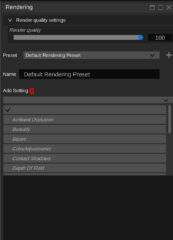
You can now explore all rendering settings to set the
desired lighting condition.
Remember to use camera aperture, shutter speed and iso to adjust
overall exposure.
How to Import Custom 3D Set In FBX
- Create an empty project
- Press Add Imported Mesh

- Browse your FBX Set
How to Import Vset3D library
- Select library icon
![]()
- Select Virtual Set
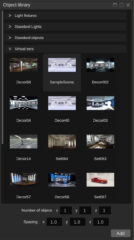
- Select a thumbnail
- Double click on it or press Add
How to Add Live Input or media
- Open Sources menu
![]()
- Press the plus icon (+) at the top right corner
- Select the desired source type

- Adjust its parameters
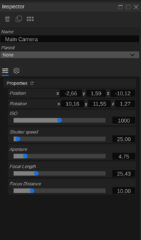
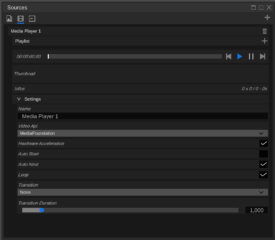
How to Add Live Output
- Open the Mixer menu
![]()
- Press the plus icon
- Press V Mixer 1
- Press > Output
- Select the desired Output method

How to Set Project Resolution & Frame
rate
- Open Setting menu
![]()
- Press > Video Settings
- Set the video standard and Render Frame rate
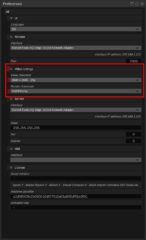
The Render Frame rate option sets Vset3D vertical synchronization
method (MainDisplay by default)
How to activate Volumetric light FX
- Set basic Ray traced project
- In the Rendering Setting Add Fog setting
- Use inspector to adjust Spot light Volumetric settings
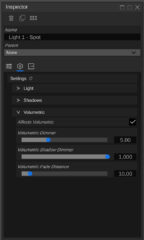
How to Animate object, camera or light
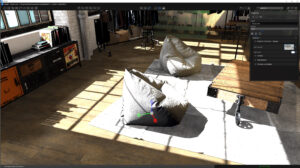
Select an Object or Light from the 3D view
- Open Animation windows
![]()
- Press the plus icon
- Press > to deploy the parameters
- Press Key Frames to deploy the Key framer
- Press Position + to add key at the current time
- Change Time
- Move the object in the 3D view
- Press Position + to add key at the new time
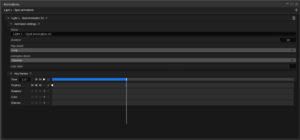
You can do the same for all available parameters. Displayed parameters depend on selected item
How to add item to the Control panel
- Select + icon
- Select the item
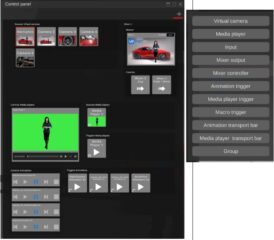
VIDEO STANDARD AND FRAME SYNCHRONISATION
You must set computer refresh rate and resolution according to your project.
To work properly, Vset3D must be running on a perfectly synchronized computer, which means that your Windows display setting must be set according to the resolution and frame rate of your project.
All media, live video and monitors must be played, streamed or set to the same frame rate.
The entire workflow should run at the same frame rate.
Use Windows NVidia Settings to set the frame rate :
Setup your computer for a 25 Fps 1080 Project
- Make sure your computer monitor supports 25Hz
- Open the Nvidia display settings and set the frequency to 25Hz
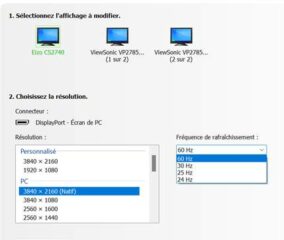
If the 25Hz is unavailable, create it with Customize menu
- Open Vset3D Studio Settings menu
- Select Video Settings
- Select 1920 X 1080 – 25P as video Standard
- Select MainDisplay as Render FrameRate
Setup your computer for a 30 Fps 1080 Project
- Make sure your computer monitor supports 30Hz
Open the Nvidia display settings and set the frequency to 30Hz
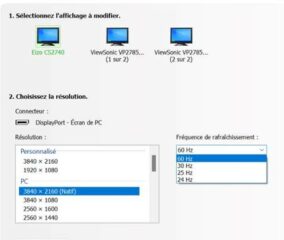
If the 30Hz is unavailable create it with the Customize menu
- Open Vset3D Studio Settings menu

- Select Video Settings
- Select 1920 X 1080 – 30P as video Standard
Select MainDisplay as Render FrameRate
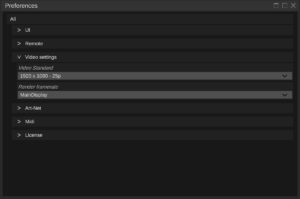
HARDWARE
- Processor Intel / AMD
- NVidia GeForce RTX 20xx, RTX 30xx, RTX 30xx graphic cards.
- 16Gb Ram.
- BlackMagic DeckLink Video capture card.
- Operating System Windows 10 or 11 64Bits.
| Reference computer 1:
· Asus ROG Maximus Z690 Formula · I7 1200KF · RTX 3090 · 32 GBytes |
Reference computer 2:
· Asus WX 299 Sage · I7-7820 3.6Ghz · RTX 3080 · 32 GBytes |
| Reference computer 3:
· Asus ROG Maximus Z690 Formula · I7 1200KF · RTX 4090 · 32 GBytes |
Vset3D primarily uses the GPU for all calculations, so if you are planning large project with lots of polygons, objects, textures, 50 or 60 fps, choose the biggest GPU possible.
Make sure your project does not exceed the memory capacity of the graphic card to avoid shared memory usage.
Using shared memory will cause performance to drop drastically
When installing the graphics card in the computer, make sure you have enough free PCIe lanes to ensure that the graphic card bus interface will operate at full speed. Use GPU-Z to check it.
PCIe lanes are the physical link between the PCIe-supported device and the processor/chipset.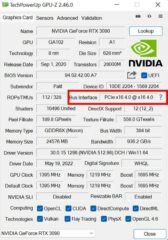
CPU Throttling
To avoid CPU throttling
- Start regedit
- Go to > HKEY_LOCAL_MACHINESYSTEMCurrentControlSetControlPower
- Add (PowerThrottling) key
- Add DWORD (32-bit), name it (PowerThrottlingOff)
- Set its value to 1
Laptop Computers
Vset3D Studio can be operate on high performances laptop.
Don’t forget Vset3D is a video production software and needs to be in sync with all your video inputs and outputs.
So when you choose your laptop, make sure it will be able to operate at video standard frequency.
This two points must be verified:
- Make sure its default frame rate is not 120Hz or higher.
- Make sure its display can be set to 50 or 25 Hz if you plane PAL projects.
If you are in one of the above cases, you can use an external monitor to set the appropriate frame rate.
Always set the display frame rate and project frame rate to the same value, otherwise you will face dropped frames
Shortcuts
Here is the list of shortcuts available in Vset3D Studio
| Ctrl + z | Undo |
| Ctrl + y | Redo |
| Ctrl + s | Save |
| R | Select the rotate tool |
| M | Select the moving tool |
| S | Select the scaling tool |
| Alt + Middle Click | Camera orientation |
| Tab | Show Hide user interface |
| Esc | Reset selected window |
| Alt + Middle Click | Pan/Tilt |
| Ctrl + Middle Click (in the camera remote view) | Roll |
| Maj + Wheel (in the camera remote view) | Move forward/backward |
| A + Wheel (in the camera remote view) | Aperture |
| F + Wheel | = Focus (Add Depth of Field in the render option to enable it) |
GPU Load Optimisation
Lights count, polygons count, textures count and size, Live outputs or inputs, render FX, Ray tracing, Shadow… All of these have direct impact on GPU load. To maintain stable frame rate and avoid frame dropping, use with care.
The following list shows their estimated GPU load.
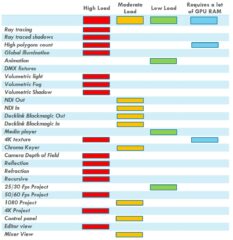
Don’t forget to use Render Quality Settings slider to save GPU load (DLSS)
Graphic Cards
Vset3D Studio is designed to use specific features of the NVidia RTX series such as real-time ray tracing and DLSS.
But you can pretty much use any decent gaming graphics card if you don’t need real-time ray tracing. AMD GPUs are suitable for non Raytrace projects.
Vset3D Studio does not take advantage of the multi-GPU setup.
Since Vset3D Studio uses the DirectX API, it is not recommended to run it on a Quadro GPU.

